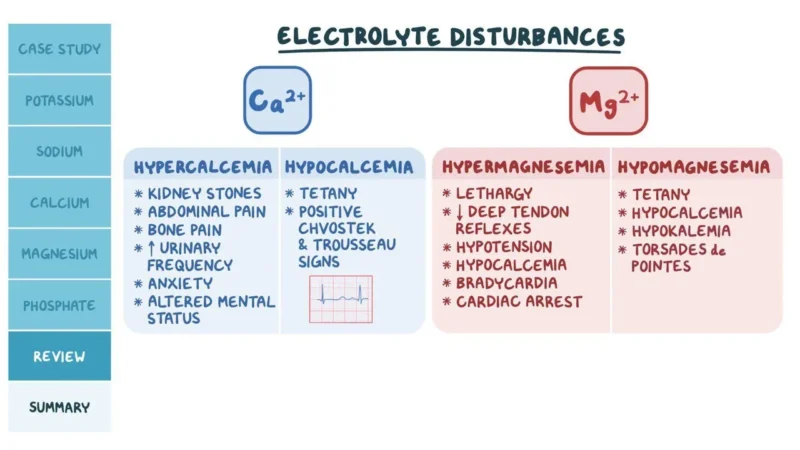Electrolytes are vital for maintaining essential bodily functions, such as muscle contractions and fluid balance.
Imbalances can result from various factors and can cause significant health issues.
Being aware of the causes, recognizing the symptoms, and knowing the treatment and prevention methods are crucial for maintaining optimal health.
Let us talk about these.
Causes of Electrolyte Imbalance
Electrolyte imbalance can stem from several common causes, with intense exercise and sweating being a primary one.
During strenuous activities, the body loses significant amounts of sodium and potassium through sweat, which can disrupt the balance of these crucial minerals.
Chronic vomiting or diarrhea also leads to substantial electrolyte loss, particularly:
-
- Sodium
-
- Potassium
-
- Chloride
The reason is that they are expelled from the body more rapidly than they can be replenished.
Certain medical conditions further contribute to electrolyte imbalances. For instance, kidney disease affects the body’s ability to regulate and filter electrolytes effectively.
Diabetes, particularly when poorly managed, can cause significant fluctuations in blood sugar and insulin levels, impacting the balance of potassium and magnesium.
Medications, such as diuretics and steroids, can also lead to imbalances by increasing the excretion of electrolytes through urine or altering their absorption in the body.
External factors like diet and dehydration due to hot weather play a critical role as well.
Diets designed for rapid weight loss often significantly reduce water and electrolyte levels, leading to imbalances.
Dehydration from excessive heat exposure or inadequate fluid intake further exacerbates this issue, making it vital to maintain proper hydration and a balanced diet.
Recognizing the Signs of Electrolyte Imbalance
Identifying the symptoms of electrolyte imbalance is crucial for timely intervention.
General symptoms include:
- Irregular heartbeat
- Muscle Cramps
- Dizziness
These symptoms indicate that the body’s electrolyte levels are not within the optimal range, affecting muscle function and cardiovascular health.
Mental confusion, fatigue, nausea, vomiting, headaches, and even seizures can also occur, pointing to severe disturbances in electrolyte levels.
Different electrolyte deficiencies present with specific symptoms. For example, a calcium deficiency might cause muscle cramping, irritability, and twitching.
Magnesium deficiency typically manifests as fatigue, weakness, and muscle spasms. Potassium deficiency is commonly associated with:
- Sugar cravings
- Fatigue
- Cramps
- Nausea
Sodium deficiency, on the other hand, can lead to confusion, irritability, and headaches.
Calcium deficiency symptoms:
-
- Muscle cramping
- Irritability
- Twitching
Diagnosing Electrolyte Imbalance

Accurate diagnosis of electrolyte imbalance requires medical tests and professional evaluation.
Blood tests, such as an electrolyte panel, are essential for measuring the levels of key electrolytes, including sodium, potassium, calcium, and magnesium.
These tests provide a clear picture of the body’s electrolyte status and help identify any significant imbalances that need to be addressed. A physical examination by a healthcare provider is also crucial.
During the examination, the provider can assess for symptoms like irregular heartbeat, muscle weakness, or neurological signs indicating electrolyte disturbance.
Seeking medical help for a precise diagnosis is imperative, as self-diagnosis can be inaccurate and potentially dangerous.
Professional guidance ensures that the appropriate treatment plan is implemented based on the specific needs of the patient.
Treating Electrolyte Imbalance
Treating electrolyte imbalance involves a combination of methods tailored to the severity of the condition.
General treatment methods include oral medications and supplements designed to restore specific electrolyte levels.
For more severe cases, intravenous (IV) fluids and medications are administered to correct the imbalance quickly. Hemodialysis may be required for patients with kidney failure or other severe conditions affecting electrolyte balance.
Dietary adjustments play a significant role in treatment. Consuming foods rich in specific electrolytes helps restore balance.
For calcium, dairy products like cheese, yogurt, and milk are excellent sources. Leafy greens, such as spinach, are high in magnesium.
Fruits like bananas and potatoes are rich in potassium. Maintaining a balanced salt intake is crucial for sodium levels. Examples of electrolyte-rich meals and snacks:
- Cheese, yogurt, and milk for calcium
- Spinach salad for magnesium
- Bananas and potatoes for potassium
- Eggs and tomato sauce for sodium
Preventing Electrolyte Imbalance
Preventing electrolyte imbalance primarily involves staying well-hydrated, particularly during and after exercise.
Proper hydration helps maintain electrolyte levels and supports overall bodily functions, such as nerve transmission and muscle contraction.
Dehydration leads to a significant loss of essential electrolytes like sodium and potassium, resulting in imbalances that affect physical performance and overall health.
It’s recommended to consume adequate fluids before, during, and after physical activity to replenish lost electrolytes and prevent dehydration.
Water is generally sufficient for short periods of exercise, but for longer, more intense activities, sports drinks that contain electrolytes can be beneficial.
These drinks help replace not only water but also sodium, potassium, and other important minerals lost through sweat.
It’s also essential to drink fluids consistently throughout the day, not just around periods of exercise, to maintain optimal hydration levels.
Dietary recommendations are also vital for prevention. A balanced diet rich in fruits, vegetables, dairy, nuts, and seeds ensures a steady intake of essential electrolytes.
For instance, bananas and oranges are excellent sources of potassium, while dairy products like milk and yogurt provide calcium.
Leafy greens and nuts are high in magnesium, and table salt, when consumed in moderation, helps maintain sodium levels.

